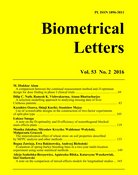
Biometrical Letters Vol. 53(2), 2016, pp. 149-163


In breeding experiments conducted prior to tests connected with the registration of new breeding lines of crops, pre-preliminary and preliminary trials are carried out. In this study a comparison was made among some models of analysis of variance, in relation to the selection of new breeding lines of spring barley (Hordeum vulgare L.). The aim is to determine whether the choice of model of analysis of variance may influence the choice of tested breeding lines. The trait considered was the yield in two years of trials. A more comprehensive analysis of variance model was found to be superior. It was also found that the results of analyses performed using average measurements for lines significantly differ from those obtained on the basis of all measurements. It was concluded that the type of ANOVA model used may have an impact on inferences about breeding lines. Moreover, a lack of stability in the yields of tested lines was revealed, implying the necessity of several years of trials.

breeding trials, genotype-environmental interaction, Hordeum vulgare L., multienvironment trials, yield

